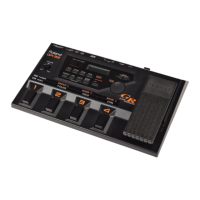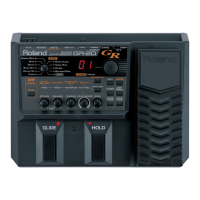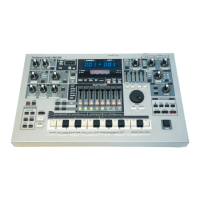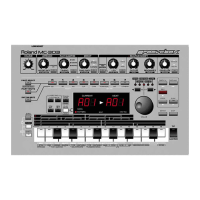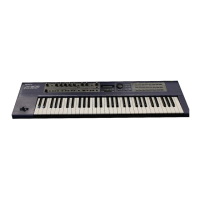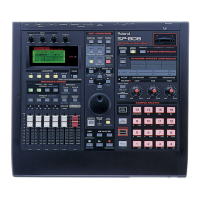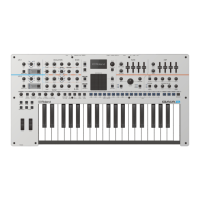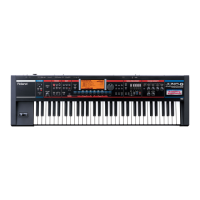✽
As in Example 1 above, it is perfectly all right to record
the arpeggios themselves with “A.-E”, then return this
data unchanged from MIDI OUT on the sequencer (to a
patch for which first and second tone arpeggios are off)
to re-create the arpeggios. However, this method cannot
be used to re-create performance where both tones were
played but only the first tone was arpeggiated.
✽
When using transmission in the Poly mode (p. 72), only
the method described for Example 2 can be used to
recording and playback.
It’s also possible to carry out recording with the GR-
30’s Arpeggiator synchronized to the sequencer’s
tempo.
First, follow the steps on p. 56 to set the ARPEGGIO/
harmony “A-TEMPO” setting for the patch to be used
to “Syn.”. Then make the connections shown in the
figure on p. 77, and in addition, use a MIDI cable to
connect the MIDI THRU connector on the external
sound generator to MIDI IN on the GR-30. Next, turn
off local control by switching on the power to the GR-
30 while holding down the [EDIT/PLAY] (p. 78), then
carry out recording. (When recording parts from an
external MIDI sound generator, turn down the VOL-
UME knob on the GR-30.)
<Recording Harmonist Effects on a Sequencer>
Example 1
Make the first tone the melody and the second tone
the harmony (or vice versa), and record the results
Set the patch “ARPEGGIO/harmony SEL” setting to
“h.-2” (or “h.-1”), and while in the same state as step 4
of “Input Procedures and Settings for Each Device”
on p. 77, play the guitar and make sure the desired
harmony is obtained. After that, continue from step 5
to record. The same harmony created when record-
ing can be reproduced by using the same patch dur-
ing playback.
Example 2
Make the notes from the external MIDI sound genera-
tor the melody and the first and second tones the har-
mony, and record the results
Set “ARPEGGIO/harmony SEL” to “h.-b”, carry out
recording in the same way as for Example 1, and play
back the performance using the same patch. Make
sure that the external sound generator and the GR-30
are set to the same MIDI channel at this time.
✽
It’s not possible to record with the GR-30 as the melody
and the external MIDI sound generator as the harmony.
✽
The setting “hAr” is not suitable for “ARPEGGIO/har-
mony SEL” when a sequencer and the GR-30 are con-
nected by a MIDI cable (local control off).
Reducing the Size of a MIDI
Pitch Bend Message
The amount of Pitch Bend messages that are sent can
be reduced by using the Bend Data Thin function.
Although the smoothness of pitch changes deterio-
rates, this can reduce the amount of MIDI data.
To call up the Pitch Bend Data Thin function, switch
on the power to the GR-30 while holding down the [-]
button. When this is done, “b” (bend data thin)
appears as the second character in the display before
the unit starts up. This results in a reduced amount of
pitch bend data transmissions until the power is
turned off. (While this function is active, the smooth-
ness of pitch changes for the internal sound generator
is also restricted.)
●●●●●●●●●●●●●●●●●●●●●●●●●●●●●●●●●●●●●●●●●●●●●●●●●●●●●●●●●●●●●●●●●●●●●●●●●●●●●●●●●●●●●●●●●●●●●●●●●●●●
<About the Bend Data Thin Function>
With the guitar, the finger vibrato technique can be
used to produce organic vibratos with amplitude and
speed that can be freely varied — something that’s
very hard to do with a keyboard.
When creating sequencer data, the GR-30 records
such finger vibratos, glissandos, and tremolo bar
usage as MIDI Pitch Bend messages. As a result of
this, the MIDI performance message that is output
contains a large number of Pitch Bend messages. In
some cases, however, these Pitch Bend messages can
greatly inflate the amount of data and exceed the
sequencer’s memory capacity.
The Bend Data Thin function is available to keep this
to a minimum.
✽
The Bend Data Thin function can also be used together
with the Polyphonic Receive function (p. 82). When this
is necessary, switch on the power while simultaneously
pressing [+] and [-].
●●●●●●●●●●●●●●●●●●●●●●●●●●●●●●●●●●●●●●●●●●●●●●●●●●●●●●●●●●●●●●●●●●●●●●●●●●●●●●●●●●●●●●●●●●●●●●●●●●●●
79
10

